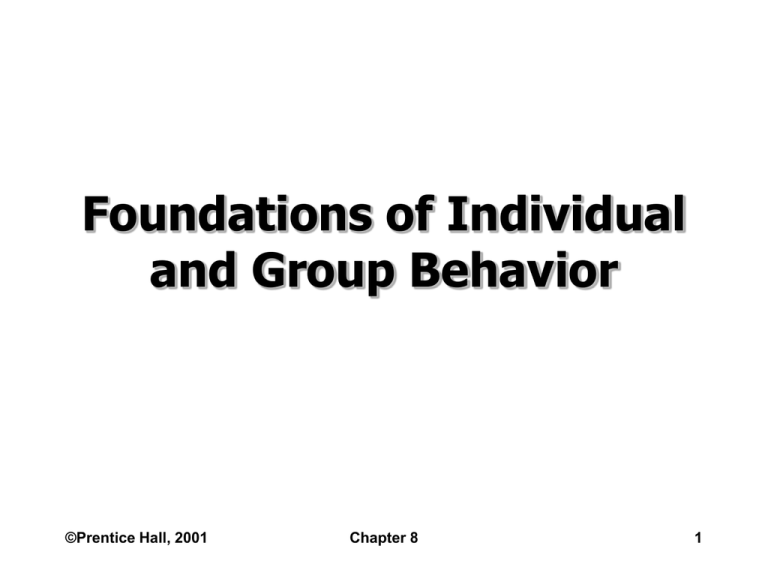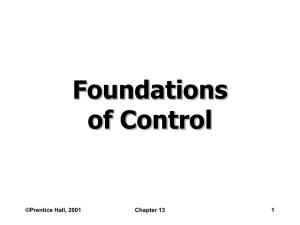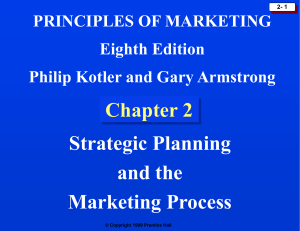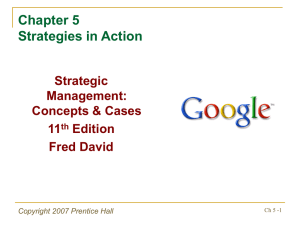Foundations of Individual and Group Behavior
advertisement

Foundations of Individual and Group Behavior ©Prentice Hall, 2001 Chapter 8 1 Learning Outcomes • Define the focus and goals of organizational behavior • Describe the three components of attitudes • Explain cognitive dissonance • Describe the Myers-Briggs personality framework • Discuss the concept of perception ©Prentice Hall, 2001 Chapter 8 2 Learning Outcomes • Explain how managers can shape employee behavior • Contrast formal and informal groups • Explain why people join groups • Discover how roles and norms influence behavior • Learn how group size affects behavior ©Prentice Hall, 2001 Chapter 8 3 Organizational Behavior OB Focus OB Goals Groups Explain Individuals Predict ©Prentice Hall, 2001 Chapter 8 4 Three Components of an Attitude Cognitive Behavioral ©Prentice Hall, 2001 Chapter 8 Affective 5 Job-Related Attitudes Job Satisfaction Job Involvement Organizational Commitment ©Prentice Hall, 2001 Chapter 8 6 Cognitive Dissonance Dissonance Elements Degree of Influence Rewards Involved ©Prentice Hall, 2001 Chapter 8 7 Managing Attitudes on the Job Dissonance Employees Productivity Low More Satisfied High High Less Satisfied Low ©Prentice Hall, 2001 Chapter 8 8 Myers-Briggs Type Indicator Type of Social Interaction Extrovert (E) Preference for Gathering Data Sensing (S) Introvert (I) Intuitive (N) Feeling (F) Preference for Decision Making Thinking (T) Perceiving (P) Style of Decision Making ©Prentice Hall, 2001 Judging (J) Chapter 8 9 Extroversion Agreeableness The “Big-Five” Personality Model Conscientiousness Emotional Stability Openness ©Prentice Hall, 2001 Chapter 8 10 Emotional Intelligence Self-Awareness Self-Management Self-Motivation Empathy Social Skills ©Prentice Hall, 2001 Chapter 8 11 Personality Traits and Workplace Behavior Machiavellian Traits SelfEsteem ©Prentice Hall, 2001 Locus of Control SelfMonitoring Chapter 8 Risk Propensity 12 Holland’s Personality-Job Fit Theory Type Personality Occupations Realistic Shy, Stable, Practical Mechanic, Farmer, Assembly-Line Worker Investigative Analytical, Independent Biologist, Economist, Mathematician Social Sociable, Cooperative Social Worker, Teacher, Counselor Conventional Practical, Efficient Accountant, Manager Bank Teller Enterprising Ambitious, Energetic Lawyer, Salesperson Artistic Imaginative, Idealistic Painter, Writer, Musician ©Prentice Hall, 2001 Chapter 8 13 Occupational Personality Types R I C A E ©Prentice Hall, 2001 S Chapter 8 14 What Is Perception? Object ©Prentice Hall, 2001 Perceiver Chapter 8 Context 15 Observation Interpretation Attribution of Cause High External Low Internal High External Low Internal High External Low Internal Distinctiveness Attribution Theory and Individual Consensus Behavior Consistency ©Prentice Hall, 2001 Chapter 8 16 Selectivity Self-Fulfilling Prophecy Assumed Similarity Judgmental Shortcuts Halo Effect ©Prentice Hall, 2001 Stereotyping Chapter 8 17 Operant Conditioning Involuntary Behavior Voluntary Behavior Unlearned Learned ©Prentice Hall, 2001 Chapter 8 18 Social Learning Theory Processes Attention Retention Motor Reproduction Reinforcement ©Prentice Hall, 2001 Chapter 8 19 Shaping Behavior Positive Reinforcement Negative Reinforcement Punishment Extinction ©Prentice Hall, 2001 Chapter 8 20 What Is a Group? Formal Informal Formally Established Occur Naturally Work Assignments Friendships Specific Tasks Common Interests ©Prentice Hall, 2001 Chapter 8 21 Security SelfEsteem Status Why People Join Groups Power ©Prentice Hall, 2001 Affiliation Goals Chapter 8 22 Basic Group Concepts Group Roles Group Norms Expected Patterns of Behavior Based on a Given Position in a Social Unit Acceptable Standards of Behavior Shared by the Members of a Group ©Prentice Hall, 2001 Chapter 8 23 Formal Status Informal Basic Group Concepts Large Size Small ©Prentice Hall, 2001 Chapter 8 24 Cohesiveness-Productivity Relationship Alignment of Group and Org. Goals Cohesiveness High Low High Strong Increase in Productivity Moderate Increase in Productivity Low Decrease in Productivity No Significant Effect on Productivity ©Prentice Hall, 2001 Chapter 8 25




